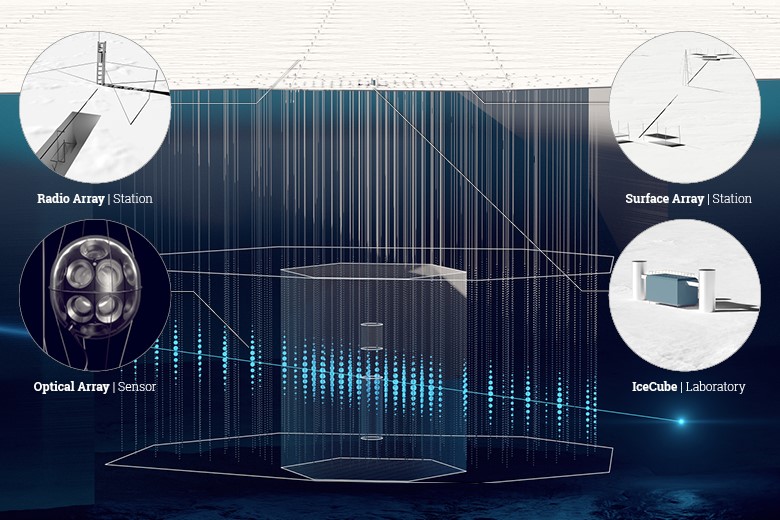From IceCube to IceCube-Gen2
With groundbreaking discoveries, IceCube has established neutrino astronomy as a new discipline for the exploration of the universe. By observing neutrinos, we can obtain knowledge about regions of the cosmos where light is unable to provide useful information. In order to fully exploit the potential of this new window to the universe, the international IceCube Collaboration is planning a significant expansion of the IceCube detector at the South Pole.
A gigantic detector deep in the ice
The detection of neutrinos requires sophisticated technology. Although neutrinos are among the most common elementary particles in the universe, they are extremely difficult to catch. Neutrinos pass through any matter almost undisturbed. To detect them despite this very little interaction, huge detectors are needed. The current IceCube detector takes advantage of its unique geographical location at the South Pole: It uses one cubic kilometer of glacial ice as a natural medium. Once a neutrino collides with an ice molecule, it creates charged particles that emit blue to ultraviolet light on their way through the ice, known as Cherenkov light. Several thousands of light sensors thousands of meters deep in the ice capture these faint light signals. The optical sensors are placed in glass spheres attached to long cables like pearls on a string and frozen in the polar ice.
IceCube-Gen2 will enlarge the detector’s volume to a gigantic eight cubic kilometers. This will increase the detection rate of cosmic neutrinos by a factor of ten. The detector will be integrated into IceCube’s existing infrastructure, and three new components will be added to it: First, the optical detector will be upgraded and expanded by adding 120 additional cables equipped with thousands of new, more sophisticated light sensors. Second, radio detectors will be set up near the surface of the ice over an area of 500 square kilometers. They will improve the sensitivity of the detector at the highest energies by two orders of magnitude. Third, an extended array on the ice surface will detect atmospheric particle showers that are triggered by cosmic rays.

Visualization of the Ice-Cube expansion to IceCube-Gen2 (Credit: DESY, Science Communication Lab)
Links
Perfect for neutrino astronomy
IceCube-Gen2 will measure the properties of neutrino sources with unprecedented accuracy. Not only will the telescope’s detection rate increase, but also the range of energies it will be able to detect – up to the highest neutrino energies. For this purpose, additional instrumentation will also record radio signals from neutrino interactions. The light yield of the optical sensors will be optimized using new technology to measure Cherenkov radiation. Artificial intelligence (AI) methods are used to transmit and evaluate the data from theses light patterns. This also enables faster reaction times to neutrino events in order to quickly point other astronomical telescopes to their sources. A surface array of particle detectors on the ice helps to distinguish neutrinos that come from outer space from neutrinos that are generated by particle collisions in the Earth’s atmosphere.

Winterover at the South Pole (Credit: Martin Wolf, TU München / IceCube, NSF).
New technology from Germany and Europe
Research groups in Germany and across Europe are already making a significant contribution to the first phase of Gen2, IceCube’s upgrade. The upgrade will be completed by 2024. The full expansion to IceCube-Gen2 will be finished by 2032. Due to the special requirements of the South Pole and the deep glacial ice, most technologies have to be developed from the ground up – for instance, smart readout systems for data transmission that use extremely energy-saving electronics while achieving maximum efficiency.
High-performance optical sensors
New sensors that are being developed for IceCube-Gen2 will be able to collect almost three times as much light as current optical sensors. Instead of a single-pixel sensor, they will use 24 pixels per sensor to detect light. About 400 of these state-of-the-art sensors will be produced for phase one of IceCube-Gen2, more than 200 of them in Germany. To increase the amount of usable light and the detectable signal, another variant of novel sensors use a new technique: Wavelength shifters slide the ultraviolet portion of the light to a wavelength that can permeate the glass containers of the sensors.
Sophisticated calibration methods
To further analyze the measured signals, it is crucial to understand in detail how light moves through the ice before being detected, and what the physical significance is of a particular signal as measured by the sensors. The IceCube team uses various calibration techniques to classify and measure both the general properties of the detector and the expected paths of light through the ice.
Artificial intelligence for neutrino searches
To classify a neutrino event as such, researchers have to put a lot of effort into comparing the light patterns of the measured signals with simulations. Simulations predict which signals to expect depending on the type of triggering event, the energy it emits, and the direction it comes from. They also take into account the properties of the glacial ice as known from the calibration data. Machine learning methods can significantly accelerate the analysis process, and quickly and reliably filter out neutrino events from the noise.
